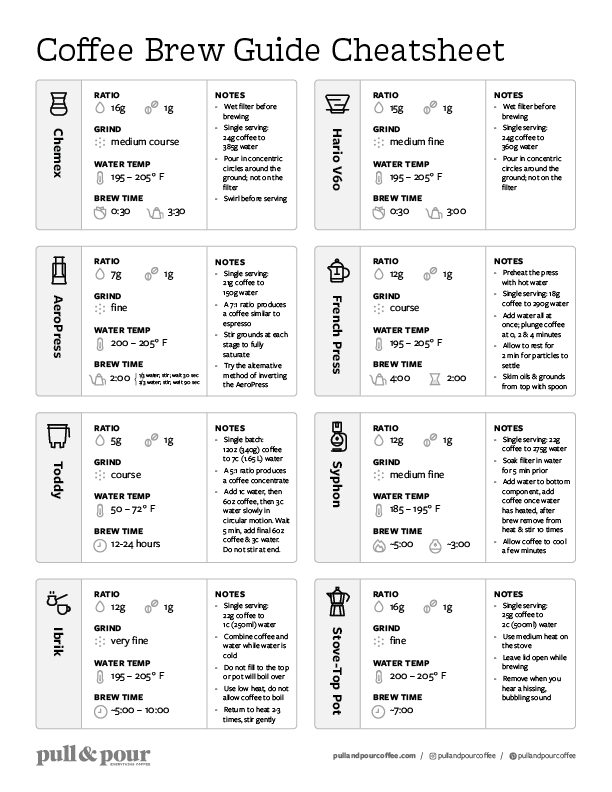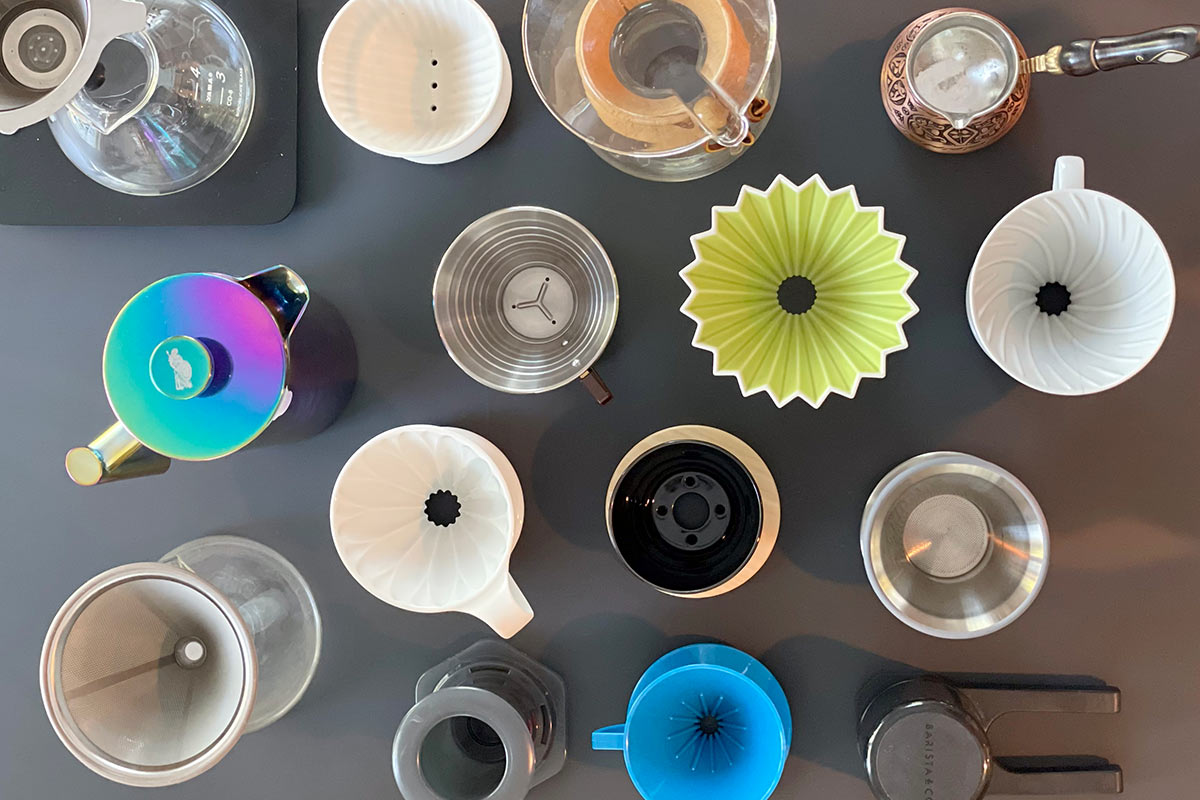When first getting into specialty coffee, the variety of brew methods can be overwhelming. This article looks to give an overview of some of the most common brew method styles, what they are, how they work and give you some tips to get started.
Before we dive into the weirdly interesting world of brew methods let me try to simplify what brewing means.
What is Coffee Brewing?
Brewing is the term used when we are preparing a liquid by steeping, boiling, fermenting or infusing it with a solid. To put it in much simpler terms, brewing is a fancier term for cooking. Our goal irrespective of the method is to extract as much of the ground coffee as possible into our cup. There is a ceiling though on how much we are able to extract of the coffee beans using the current brewing methods we have. With advancement in brewer design and experimentation in new brewing techniques we are able to extract more from coffee than ever before.
Extraction yield refers to the solubles dissolved during brewing. This is often expressed as a percentage of the coffee’s mass. It is also known as solubles yield or simply extraction.
The Different Brew Methods
The various brew methods get their names based on how water passes through the coffee bed. The different coffee brew methods are:
The same coffee when brewed using multiple brew methods will present different experiences for each brew method. The taste of the coffee, the mouthfeel, body, etc. will tend to be different.
In the following section I will talk about each brew method briefly to give you a glimpse on how the coffee gets brewed, the generic designs of the brewer and how the final coffee tends to taste with each method.
Immersion Method
Overview of Immersion Brewing
As the name suggests, coffee is immersed in water for a stipulated amount of time after which the coffee slurry is either strained out using a filter or it’s left to settle down at the bottom of the brew vessel and the coffee which remains on top is poured out. This is by far the simplest brewing method and it requires the least amount of interaction with the coffee.
Slurry: The mixture of coffee grounds and water created during brewing. Not typically used to refer to brewing methods where the coffee is more or less held in place, as in espresso brewing, moka pots, or American Press.
Brewer Design for an Immersion Brewer
The brewer design which uses the immersion method are highly basic with a brew chamber and a mesh to filter the slurry or the coffee is let to settle down in the brewer and the coffee devoid of sediments gets poured into the cup. Examples of immersion brewers are the French Press, Turkish Ibrik and cold brew.
Cup Characteristics of an Immersion Brew
The final cup tends to have a nice body with a host of flavors. In my personal opinion coffee brewed with a French press pairs beautifully with a heavy breakfast.
recently immersing coffee in cold water and letting it steep for 18-24 hours or longer in some cases has become trendy. As the acidic compounds in the ground coffee tend to dissolve easily in hot water, coffee brewed using the cold brew method tends to have little to no acidity but does have a rich body to it.
Free Download
Download the free, printable coffee brew guide cheatsheet
- Quick reference for ratios, water temp & brew times
- 8 brew methods including chemex, V60, aeropress & more
- Serving sizes and tips for each brew method

Pour Over (or Percolation) Method
Overview of Pour Over Brewing
Pour over (or percolation) brewing is the name given to coffee that is made using a device like a Chemex, a V60 or a Kalita Wave. In the pour over method water is poured on to a bed of coffee and as the water makes its way through the coffee bed it extracts the coffee before passing through a filter and making its way into the cup.
Brewer Design for a Pour Over Brewer
The brewers designed for this method have a few key features. They have either vertical or conical walls and have a single large hole (conical brewers) or multiple small holes (flat bottom brewers) through which the coffee will exit the brewer. They are designed in such a way that they can hold a filter between the top and bottom of the brewer.
The coffee is dosed into the filter and water added in stages till the desired water weight is reached. The water gradually percolates through the loosely packed coffee bed and makes its way into the cup. Examples of pour over brewers include Hario v60, Fellow Stagg X, Chemex, and Kalita Wave.
Cup Characteristics of Pour Over Brewing
Pour over brews tend to have a much cleaner taste profile and lesser body as compared to an immersion brew. Since the coffee passes through a fine filtration process, the flavor notes can be tasted clearly and it’s this clarity in the cup that most people tend to enjoy.
Vacuum Method
Overview of Vacuum Brewing Method
The vacuum pot (also known as a syphon) is the only brewer that is capable of brewing coffee using the vacuum method. Difference in pressure between the brew chamber and the water vessel causes the water to rise up and pass though the coffee. Even though the coffee gets immersed during the initial half of the brew and the water later percolates through the coffee bed to make its way back into the water vessel the primary force behind this brew method is the vapour pressure and hence it doesn’t classify as a hybrid method.
Brewer Design for a Vacuum Coffee Brewer
The siphon has a unique design and it often tends to catch your eye when you see it in a coffee shop. It looks like a piece of equipment taken out of a chemistry lab. The brewer has two chambers, the bottom chamber houses the water and is exposed directly to the heat to heat up the water. The top chamber holds the ground coffee in it and is also the brew chamber. A pipe leads down from the brew chamber to the bottom chamber and the water uses this pipe to head up and down to and from the brewing chamber. As the water is heated the pressure in the bottom chamber rises and forces the water to go through the pipe and into the brewing chamber. For as long as the heat is supplied to the bottom chamber the pressure below will be greater than the pressure above and the water will remain on top. Once the heat has been cut off, the bottom chamber begins to cool and with it the pressure below drops and the water along with the dissolved coffee falls back into the bottom chamber.
Cup Characteristics of Vacuum Brewing
The coffee generally has a crisp body and does have a cleaner taste profile as compared to the immersion brew. The vacuum brews can produce great cups of coffee but its easier to get the brews wrong as there are multiple things going on as the brew progresses and a slight variation in the recipe can lead to an unevenly extracted cup.
Pressure Method
Overview of Pressure Brewing Method
The pressure method for coffee brewing utilizes some sort of pressure to push the water through the coffee bed. The coffee that is used in this method is ground to a pretty fine consistency. This is because the contact duration between the water and the coffee is pretty short and a finer grind size aids in a much better extraction. The volume of coffee that gets generated using this method is pretty small as compared to other methods but the level of extraction is nearly the same.
Brewer Design for a Pressure Coffee Brewer
The coffee brewers using the pressure method have a water chamber and the water is heated using either an internal or external heat source. The steam that is generated by heating the water is used to push the water through the ground coffee. There are several brewers that have a lever and use manual force to apply pressure onto the water and push it through the coffee bed. Some examples of coffee brewers that use the pressure method include an espresso machine and the moka pot.
Cup Characteristics of Pressure Brewing
The coffee has a nice heavy body to it because of the high extraction to the low volume of coffee. Well prepared espressos have a nice overall smooth velvety finish to it. Moka pots do not tend to have the same body and finish as compared to an espresso because the pressures generated in a moka pot is significantly less as compared to that generated by an espresso machine.
Free Download
Download the free, printable coffee brew guide cheatsheet
- Quick reference for ratios, water temp & brew times
- 8 brew methods including chemex, V60, aeropress & more
- Serving sizes and tips for each brew method

Hybrid Method
Overview of Hybrid Brewing Method
The hybrid method involves one or more of the above methods but more often than not it uses the immersion and pour over methods in tandem. Some brewers even have a pressure element incorporated in the brewing process but the pressures that are generated are considerably lower than pressures developed by an espresso machine.
Brewer Design for Hybrid Coffee Brewers
Since these brewers have multiple brewing methods the design will reflect the same. The brewers will have an immersion and a pour over capability and where pressures can be generated to push the water most likely there will be a piston that can be pushed manually to generate the pressure.
Cup Characteristics of Hybrid Brewing
The coffee would taste like you would expect it to; it will have the clarity of the pour over brew to a certain extent and also a nice body to the coffee due to the coffee being immersed in water. The pressure element doesn’t tend to add much to the taste profile as the pressures are quite low in this method.
Summary
The biggest take away in identifying how the brewer brews coffee is to see how the water is passed through the coffee bed. Each brew method tastes different and has certain characteristics to it that make it stand apart from the other methods. The same coffee brewed using different brew methods might give off different flavor notes or cup characteristics. Playing with the same coffee using multiple methods is a lot of fun too.
There is a lot more to each brew method and to do justice to each one it would warrant an independent post. Though all this information may seem a lot to digest at first, but if you take a moment to look at the entire coffee brewing process as a whole, the ultimate goal is the same and even though the path to achieve the goal of having a great cup may differ the process isn’t all that different from one another. The more you brew the better your intuition grows for brewing each process and when you have brewed a great cup of coffee it puts a nice smile on your face and I feel that’s a great way to begin your day.
